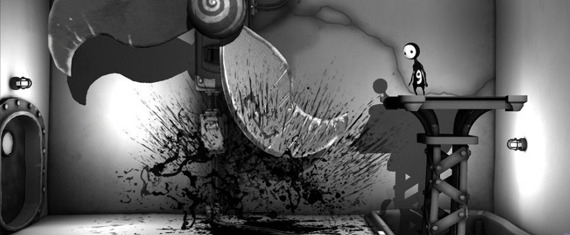 Much like the first SNES got gamers used to a console controller with six buttons, the PS Vita’s initial titles are providing a gentle introduction to the system’s various input options. Escape Plan fits that mold perfectly, a tactical puzzle game that starts with primarily front-touch controls but ramps up in complexity by eventually using front and back inputs, both thumbsticks, gyroscopic recognition and creative combinations of all three. The result is an interesting proof of concept for the hardware, but it doesn’t necessarily equate to a great game.
Much like the first SNES got gamers used to a console controller with six buttons, the PS Vita’s initial titles are providing a gentle introduction to the system’s various input options. Escape Plan fits that mold perfectly, a tactical puzzle game that starts with primarily front-touch controls but ramps up in complexity by eventually using front and back inputs, both thumbsticks, gyroscopic recognition and creative combinations of all three. The result is an interesting proof of concept for the hardware, but it doesn’t necessarily equate to a great game.
Escape Plan is essentially Portal meets Lemmings, which on the surface will have you screaming “for the love of God, I need this game now!” Like Portal, Escape Plan sees you guiding a captive — in this case two of them, cartoony blobs named Lil and Laarg — through a series of puzzle-based levels that increase in difficulty as the game goes on. The puzzles aren’t always physics based as they are in Portal, but they do rely on gravity and inertia at times. Like Lemmings, you have to carefully navigate various obstacles to reach each level’s exit, even avoiding enemies in later stages, while controlling the movements of Lil and Laarg, each of whom has specific purposes and abilities.
Lil is a fast-moving, lever-pulling creature that gets even faster after consuming in-game coffee. Generally speaking, his speed is required, and the coffee machines are always there to indicate his speed needs to increase further to dash past an obstacle. Moving Lil (and Laarg as well) is accomplished by swiping your finger over them in the direction you want to travel. Dashing, meanwhile, is possible by tapping the coffee maker to instruct Lil to go use it, then literally squishing him between your fingers using both the front and rear touchpads on the PS Vita hardware. One squish lasts about 10 scale feet, so many obstacles require repeated squishing to get Lil past. Lil can also inhale helium and inflate like a balloon, which in turn requires using the Vita’s gyroscopic controls to safely maneuver him through the level. Tapping him while inflated causes him to fart, thus losing helium and eventually sinking to the ground.
Laarg, on the other hand, is the proverbial big oaf, a slow-moving rotund beast of a creature that lumbers through levels but can bash through walls and collapse fragile flooring if instructed to do so by swiping in the respective direction of the obstacle. His weight can also be used to stand on certain switchplates to activate various doors and other environmental objects, so you’ll often find yourself tapping him at precise times to indicate when it’s time for him to stop moving.

Lil and Laarg aren’t the only things you interact with or move, mind you, which is what provides some of Escape Plan’s most interesting moments. For instance, many levels include fans (as shown above) that you need to manually spin via the Vita’s touchscreen to slow down or clear a room of smoke. There are also poison-emitting pipes that can be “plugged” by holding your finger over them, platforms that can be extended for Lil to jump onto by tapping the rear touchscreen, and obstacles that need to be pushed out of the way by tapping on either the rear or front touchscreen depending on the object and scenario. This control of character and environment really provides some unique engagement and gameplay opportunities.
With that said, there comes a point in Escape Plan where it feels like SCEA’s exhausted its bag of interactive tricks and left you doing the same thing over and over. The gameplay mechanics and environments are all interesting, but they just start to feel old. It’s hard to put a finger on just what makes Escape Plan feel this way; the level design certainly isn’t repetitive, and the brain-teaser navigation seldom repeats itself. Still, the game just starts to feel as if you’ve been there, done that after a few hours of play, which is a tad disappointing. Interacting with Lil and Laarg can also prove a bit finnicky, as they either won’t always respond to inputs at all or will respond late, thus causing you to swipe at them multiple times and affect your end-level score (which is based on number of swipes and completion time).
Escape Plan’s artistic direction certainly isn’t a disappointment, though, as any fan of the movie The Artist will happily tell you black-and-white presentations aren’t devoid of creativity. Much has been said about the PS Vita’s gorgeous OLED screen, and rightfully so. But seeing the black-and-white presentation of Escape Plan is a testament to the system’s high-contrast, razor-sharp display and really helps you focus on the puzzle and task at hand rather than distracting you with color. Escape Plan really is a pretty game, and it makes nice use of lighting and fog/smoke effects, so don’t let its monochromatic tone deter you.
Normally I’d recommend trying a demo first to see if you like the gameplay style, but a short demo of Escape Plan won’t give you sufficient time to determine whether the mechanics eventually feel as repetitive for you as they did for me. If you’re willing to roll the dice, the first several hours of Escape Plan for the PS Vita won’t disappoint, and with any luck the later levels won’t either.
Score: 7 — Occasionally touchy controls and an inexplicable feeling of repetition undermine an otherwise creative tactical puzzle game.
Platform reviewed: PS Vita
